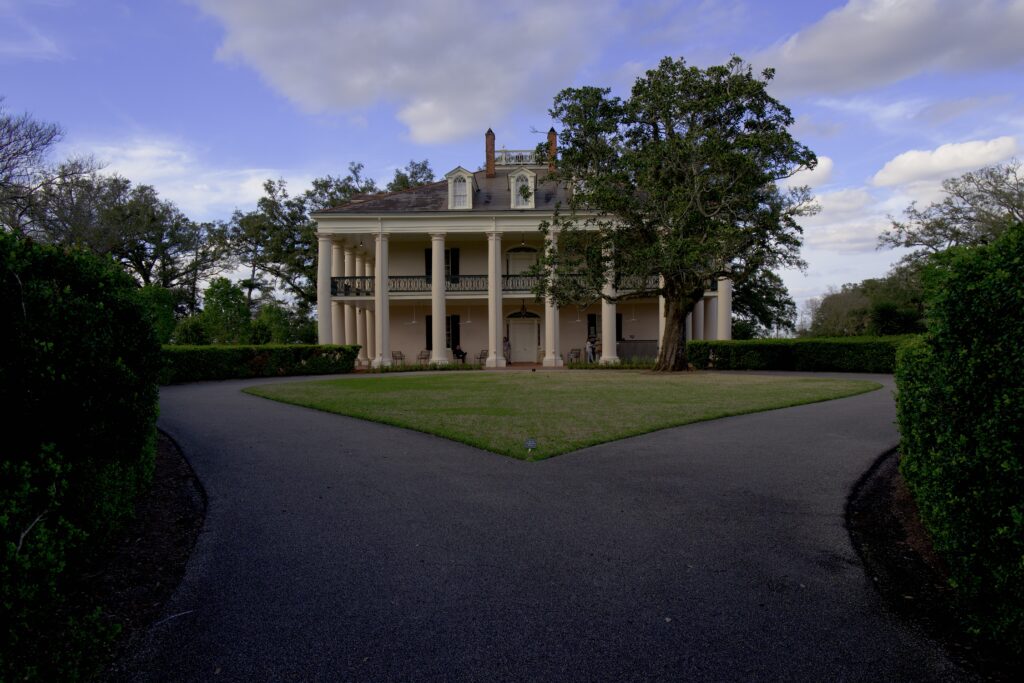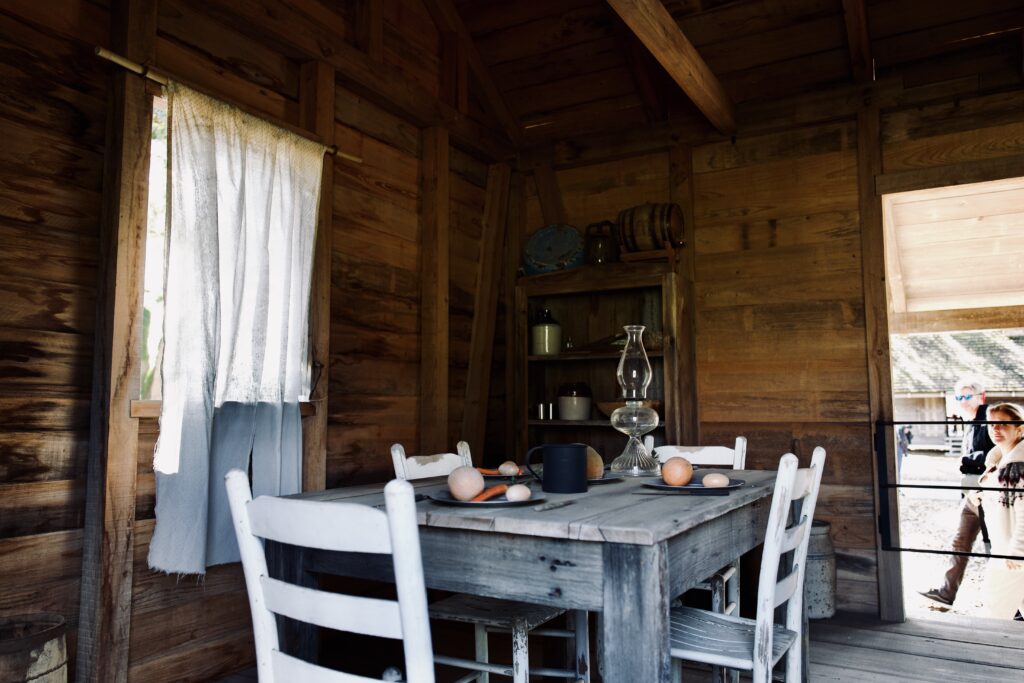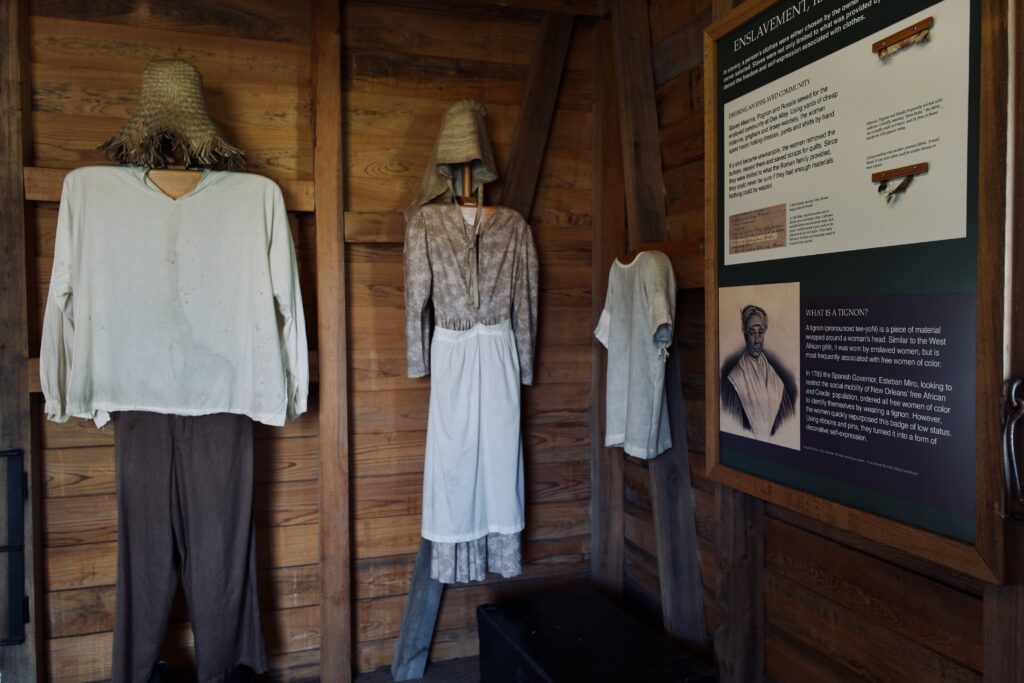
Oak Alley Plantation~ Slavery and the South
Oak Alley takes its name from a row of 28 live oak trees (Quercus virginiana), native to this region. Stretching from the mansion to the Mississippi River, they have witnessed the evolution of the plantation.

Antebellum Aristocracy: Wealth and Power in the South
As I walk through the rows of Oak trees leading to the ‘Big House’, I can’t help but feel a sense of foreboding mixed with wonder. This feeling arises from a variety of factors, including the plantation’s history of slavery and the stark contrast between the grandeur of the plantation home and the harsh reality of life for enslaved people on the plantation.

Oak Alley Plantation is a well-known example of the antebellum South, referring to the period before the American Civil War when the southern states were characterized by their reliance on agriculture, particularly cotton and sugar cane, and their dependence on slave labor.
History
The story begins in the early 19th century, a wealthy Louisiana sugar cane farmer named Jacques Roman . He wanted to build a magnificent plantation home that would showcase his wealth and status in the community. He chose a spot on the banks of the Mississippi River, where a double row of magnificent oak trees formed an awe-inspiring alley leading up to his new home.
Jacques Roman named the plantation “Bon Séjour,” which means “good stay” in French. The name was fitting, as the plantation quickly became a popular destination for visitors from across the region. Jacques Roman’s new home was the epitome of luxury, with spacious rooms, grand staircases, and exquisite furnishings.
However, the grandeur of Bon Séjour was built on a dark and tragic legacy. Jacques Roman relied heavily on slave labor to maintain his plantation’s operations, and the enslaved people who worked on the plantation were subjected to harsh conditions and treated as property rather than human beings.
One of the most enduring legacies of Bon Séjour is the double row of oak trees that line the plantation’s entrance. These trees, which are over 300 years old, have witnessed centuries of history and are a powerful symbol of the antebellum South.
Over time, the plantation changed hands and underwent various transformations. In the 1920s, a new owner renamed the plantation “Oak Alley” to capitalize on the fame of the oak trees that had become synonymous with the property. The plantation eventually fell into disrepair, but was saved from destruction by a group of preservationists in the 1960s.
Plantation Life: A Look Inside the Antebellum South



Life for slaves at the Oak Alley plantation was harsh and oppressive. Enslaved people were considered property, bought and sold like animals, and subjected to brutal physical and emotional abuse at the hands of their owners. They were forced to work long hours in the fields, planting and harvesting crops, often in extreme heat and humidity.
In addition to working in the fields, slaves at Oak Alley were also forced to work in the sugar mill, where they were responsible for crushing the sugar cane and processing it into sugar. This work was extremely dangerous, with workers at risk of serious injury or even death from the heavy machinery.
Slaves at Oak Alley were housed in small cabins or barracks, often with little more than a dirt floor and no heat or running water. Families were often separated, with children being taken away from their parents and sold to other plantations. Enslaved people were forbidden from learning to read or write, and any attempts to escape or rebel against their owners were met with severe punishment, including beatings and even death.
Despite these horrific conditions, enslaved people at Oak Alley and other plantations across the American South managed to build strong communities, forge relationships with each other, and resist the brutality of their enslavement in various ways. Some escaped to freedom through the Underground Railroad, while others engaged in acts of rebellion or sabotage, such as breaking tools or slowing down their work pace. The legacy of these enslaved people and their struggle for freedom is an important part of American history and must be remembered and honored.

Navigating the Legacy of the Past
Yes, Oak Alley Plantation is now a popular tourist attraction in Louisiana, drawing visitors from around the world who are interested in learning about the history of the antebellum South and the lives of enslaved people who lived and worked on the plantation. Visitors to the plantation can take guided tours of the property, including the “Big House” (the main plantation house), the slave quarters, and the surrounding grounds.
The Oak Alley Plantation is also a popular venue for weddings and other events, and the plantation hosts a number of special events throughout the year, such as the annual Fall Arts and Crafts Festival and Christmas bonfires.
In recent years, the plantation has faced criticism for its portrayal of slavery and the lives of enslaved people. Some have argued that the plantation’s focus on the grandeur of the “Big House” and the beauty of the grounds downplays the horrors of slavery and ignores the experiences of those who were enslaved at the plantation. The plantation has responded by incorporating more information about the lives of enslaved people into its tours and exhibits, and by working with historians and other experts to provide a more accurate and nuanced view of the plantation’s history.
My take from my shot visit to Oak Alley plantation- South is a region of resilience and growth, with a rich cultural heritage, a strong sense of community, and a growing diversity of people and ideas. Navigating the legacy of the past is an ongoing challenge, but it is also an opportunity for growth and transformation, as individuals and communities work to build a more just and equitable future.
